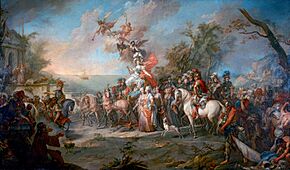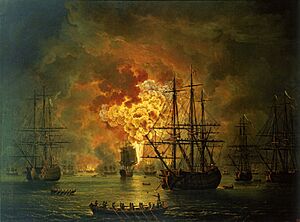Russo-Turkish War (1768–1774) facts for kids
Quick facts for kids Russo-Turkish War (1768–1774) |
|||||||||
|---|---|---|---|---|---|---|---|---|---|
| Part of the series of Russo-Turkish wars | |||||||||
 Allegory of Catherine's Victory over the Turks (1772), by Stefano Torelli. |
|||||||||
|
|||||||||
| Belligerents | |||||||||
Emirate of Palestine Greek insurgents |
|
||||||||
| Commanders and leaders | |||||||||
Jan Hendrik van Kinsbergen Zahir al-Umar Panagiotis Benakis |
(1768–1774) (1774) |
||||||||
The Russo-Turkish War of 1768–1774 was a big fight between the Russian Empire and the Ottoman Empire. Russia won this war, which helped them gain more power and land. This victory brought areas like Yedisan (between the Bug and Dnieper rivers) and Crimea under Russian influence.
Even though Russia won many battles, they didn't take as much land as you might expect. This was because other European countries wanted to keep a balance of power. They didn't want Russia to become too strong in Eastern Europe.
Still, Russia became one of Europe's main military powers. They took advantage of the weakened Ottoman Empire and the end of the Seven Years' War. This war also helped Russia gain more control over the Polish–Lithuanian Commonwealth. This eventually led to the First Partition of Poland, where Poland's land was divided among its neighbors.
The Ottoman Empire lost a lot in this war. It showed that they were no longer a big threat to Europe. The war also started a long period of arguments among European countries about the "Eastern Question." This was about what would happen to the Ottoman Empire as it grew weaker.
Contents
Why the War Started: Key Reasons
Trouble in Poland: A Russian Connection
The war began because of problems in Poland. Russia had a lot of control over Poland's king, Stanisław August Poniatowski. He was chosen because he was a friend of the Russian Empress Catherine II of Russia.
The Russian ambassador, Nicholas Repnin, forced Poland to sign a treaty in 1768. This treaty was bad for Poland. It allowed Russian troops to stay in Warsaw. Many Polish nobles, Catholics, and farmers were unhappy. They formed a group called the Bar Confederation to fight back.
One of their leaders was Casimir Pulaski. Even though the Russian army was much bigger, the rebels fought a guerrilla war. In June 1768, Russian troops chased some rebels into Ottoman land. This led to a fight between Russian Cossacks and Ottoman soldiers. This clash helped start the war.
The Ottoman Empire's Situation

The Ottoman Empire also had many problems inside its own country. Different groups were rebelling against Sultan Mustafa III. The Ottomans were also fighting a strong Persian empire in Iraq.
At first, the Ottomans seemed to have an advantage. Russia was low on money from the Seven Years' War. The Ottoman Navy was stronger than the Imperial Russian Navy in the Black Sea. This meant the Ottomans could move supplies more easily. They also had soldiers from their ally, the Crimean Khanate.
However, the Ottoman Empire had many internal problems. Their new leader, Mehmed Emin Pasha, was not a good military commander. Also, the Russian army was ready along the borders, making it hard for the Ottomans to attack Russia.
Russia Attacks: The War Begins
In the summer of 1768, Cossacks (who were paid by Russia) chased Polish rebels into Ottoman territory. Reports said the Cossacks attacked the town of Balta. Russia denied this, but the Ottoman Sultan Mustafa III was angry. On October 6, he arrested the Russian ambassador and declared war.
Catherine II of Russia was shown in portraits wearing British military uniforms after her victories. Britain was an ally at first because they traded a lot. Britain needed iron, sailcloth, and timber from Russia for its growing industries and navy. But when Russia started winning, Britain worried Russia would become a competitor. They reduced their support.
In January 1769, a large Turkish-Tatar army, led by Crimean Khan Qırım Giray, attacked central Ukraine. They took many people as slaves. But the Russian soldiers at the Fortress of St. Elizabeth stopped their attack.
On September 17, 1769, the Russians began their main attack into Moldavia. The Ottoman soldiers fought hard at Khotyn, but the rest of the Ottoman army ran away. The Russians took the fortress. They then captured the capital of Moldavia, Jassy, on October 7. They continued south into Wallachia, taking its capital, Bucharest, on November 17.
The Ottoman Grand Vizier, Mehmed Emin Pasha, tried to stop them at the Battle of Kagul on August 1, 1770. But the Russians completely defeated his forces. Many Ottoman soldiers drowned in the Danube River while trying to escape.
Fighting in the Caucasus Mountains
Russia also sent some troops south into Georgia. In 1769, this small Russian force helped the Georgians. The Georgians defeated an Ottoman army at Aspindza in 1770.
A combined Russian-Georgian force tried to capture Poti on the Black Sea coast in 1771, but they failed. Russian troops left the area in 1772. This was the first time Russian soldiers had crossed the Caucasus mountains.
Russian Fleet in the Mediterranean Sea

During the war, a Russian fleet sailed into the Mediterranean Sea for the first time ever. This fleet came from the Baltic Fleet. Its goal was to make the Ottoman navy leave the Black Sea.
In Ottoman Greece, the arrival of the Russian fleet caused a revolt against the Ottomans. However, the Ottomans sent troops from Albania to stop this revolt in 1771.
A major sea battle happened near the city of Chesma on June 24, 1770. Twelve Russian ships fought twenty-two Turkish ships. The Russians used fire ships to destroy the Ottoman fleet. This defeat at Chesma greatly lowered the spirits of the Ottomans. It also made the Russians feel more confident. Empress Catherine II even had medals made to celebrate this victory.
Despite their success at sea, the Russians could not capture Constantinople. This was because of strong Ottoman defenses. Also, other European countries worried that taking Constantinople would upset the balance of power.
In 1771, Ali Bey al-Kabir, a ruler in Egypt, joined forces with Zahir al-Umar, a leader in Acre. They rebelled against the Ottomans. The Russian fleet helped these rebels. They helped in the Battle of Sidon and even attacked and occupied Beirut. The Russians gave Beirut back to a local leader only after he paid a large amount of money.
In 1773, the Russians occupied Beirut a second time. They did this to make the local leader pay another ransom.
Peace Talks and Final Battles
Prussia, Austria, and Great Britain offered to help Russia and the Ottomans make peace. They wanted to stop Russia from expanding too much. Austria managed to gain some land, Bukovina District, from the Ottomans in 1771.
Catherine II was worried about the Austrian army being close to her forces. She feared a bigger European war. So, she agreed to a plan to divide Poland. She also secretly agreed to give back the lands she had captured from the Ottomans. This made Austria less worried about Russia becoming too strong in the Balkans.
A ceasefire (a stop to fighting) began on May 30, 1772. But peace talks were difficult. They broke down over the issue of Crimea. However, the truce was extended until March 20, 1773. Both sides had reasons to keep talking. The Ottomans were dealing with rebellions in Egypt and Syria. The Russians were worried about Sweden, which had a new strong king.
On June 20, 1774, the Russian army, led by Alexander Suvorov, defeated the Ottoman army near Kozludzha. This victory forced the Ottoman Empire to agree to Russia's terms for peace.
The Peace Treaty: What Changed
On July 21, 1774, the Ottoman Empire had to sign the Treaty of Küçük Kaynarca. This treaty didn't take huge amounts of land directly from the Ottomans. Poland had already lost land. Here are the main points of the treaty:
- The Crimean Khanate became formally independent from both empires. But in reality, it became dependent on Russia. Russia later took full control of Crimea in 1783.
- Russia received 4.5 million rubles as payment for the war.
- The Ottoman Empire gave Russia two important seaports: Azov and Kerch. This gave the Russian navy and merchant ships direct access to the Black Sea.
- Russia gained the land between the Dnieper and Southern Bug rivers.
- The Ottomans gave up their claims to Kabardia in the North Caucasus.
- Russia gained the right to protect Orthodox Christians living in the Ottoman Empire. This gave Russia a reason to get involved in Ottoman affairs later on.
Because of this treaty, the Ottomans also gave the northwestern part of Moldavia (later called Bukovina) to the Habsburg Empire (Austria).
Russia quickly used the Treaty of Küçük Kaynarca as an excuse to start more wars and take more land from the Ottoman Empire. This war was a small part of Russia's long history of expanding its empire south and west in the 18th and 19th centuries.
See also
- History of the Russo-Turkish wars
- Greek Plan
Images for kids
Sources
- Aksan, Virginia. "The One-Eyed Fighting the Blind: Mobilization, Supply, and Command in the Russo-Turkish War of 1768–1774." International History Review 15#2 (1993): 221–238.
- Aksan, Virginia. "Breaking the spell of the Baron de Tott: reframing the question of military reform in the Ottoman empire, 1760–1830." International History Review 24.2 (2002): 253–277.
- De Madariaga, Isabel. Russia in the Age of Catherine the Great (1981) pp 205–14.







